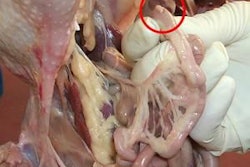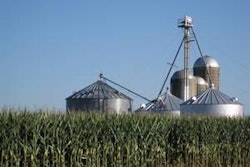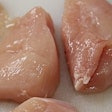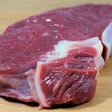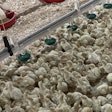
A number of issues of current interest to the U.S. egg industry were considered at the 82nd Northeastern Conference on Avian Diseases held from September 22-23 at the Conference Center, Pennsylvania State University.
Prebiotic, probiotic feed additives
Presentations were made by Dr. Carrie Walk, of AB Vista; Dr. Billy Hargis, of the University of Arkansas; Dr. Andrew Yersin, of Kemin Agri-Foods; and Dr. Randy Chick, of Danisco Animal Nutrition. The program was organized to provide health professionals in the industry with an overview of prebiotic availability and use.
Dr. Walk considered the three classes of prebiotics, including fructooligosaccharides, mannanoligosaccharides and glactooligosaccharides. The prebiotics are essentially non-digestible feed ingredients that beneficially affect the host by stimulating the growth and activity of specific bacteria in the distal intestinal tract. Prebiotics are resistant to absorption and hydrolysis in the proximal intestinal tract but can be fermented by intestinal flora especially in the colon and ceca. The mode of action of prebiotics has not been defined but may include one or more of the following:
- Binding to pathogenic bacteria;
- Promoting the growth of beneficial Lactobacillus and Bifidobacteria by providing a nutrient source;
- Changing the intestinal environment to promote proliferation of beneficial organisms by altering intestinal pH, stimulating short chain fatty acid production and stimulating antibacterial toxins; and/or
- Stimulating the immune system.
Beneficial bacteria in the distal intestinal tract use lactic acid and short chain fatty acids as substrates. Prebiotics are essentially derivatives from yeast cell walls. These products are relatively inexpensive, are GRAS and have beneficial effects similar to antibiotics without the obvious statutory and market restrictions associated with non-defined probiotic cultures and antibiotics.
Dr. Billy Hargis reviewed the history of probiotics with special reference to seeding the intestinal tract of chicks to promote resistance to salmonella and to encourage growth. The University of Arkansas has patented and licensed FloraMax®-B11. The constituent probiotic bacteria include Lactobacillus spp. Lactic acid probiotics are restricted in terms of shelf life, heat lability and compatibility with other ingredients in the diet. Bacillus spore products are often ineffective as the process of germination is extremely variable for reasons which are not clearly defined.
Dr. Andrew Yersin reviewed probiotics, which he referred to as “direct fed” (DFM) products. Generally, it is accepted that probiotics exert their beneficial function by modulating the composition of intestinal flora.
- Probiotic organisms may elaborate antibacterial compounds which inhibit potential pathogens.
- They compete for adhesions sites.
- They compete with nutrients for potential pathogens.
The characteristics of an acceptable probiotic include:
- Containing sufficient viable organisms of a strain, which is capable of providing a beneficial effect;
- Being non-pathogenic and non-toxic;
- Surviving and proliferating in the intestinal tract, which implies resistance to a wide pH range and organic acids; and
- Demonstrating a prolonged stable shelf life.
Kemin now markets CloSTAT®, but as with all probiotics, manufactures are enjoined by the FDA from making specific therapeutic label claims.
In summary, both prebiotics and probiotics have the potential to enhance performance and profitability.
- Probiotics and prebiotics are compatible with drug-free production.
- Products from reputable manufactures may provide benefits with respect to pullet development, livability and egg production of flocks.
- Probiotics are relatively inexpensive.
- Measuring improvements in performance or quality is extremely difficult under field conditions.
- Prebiotics and probiotics may have their greatest benefit in attaining optimal growth and resistance from salmonella in newly placed chicks.
Salmonella screening
Dr. D. Bautista, of the University of Delaware, evaluated a salmonella PCR screening assay using the DuPont Qualicon Bax® method. Trials conducted under controlled conditions demonstrated 100% specificity and sensitivity. The occurrence of false positives is extremely low using a range of samples including feces.
Focal duodenal necrosis
Dr. Eric Gingerich reviewed focal duodenal necrosis (FDN) in egg production flocks. The presentation was a report based on experience and papers presented at regional and national meetings relating to the condition since it was first described in 1996 by Dr. Patty Dunn at Pennsylvania State University.
AHA approval of enriched cages
Tim Amlaw, of the American Humane Association, reviewed the AHA Certification Program with specific reference to enriched colony cages which have been endorsed by the association, in contrast to the rejection by HSUS. Details of the standards for enriched colony cages and aviary systems were provided. An interesting personal observation is that Amlaw forecast that 35% of caged hens in the U.S. would be housed in enriched or enrichable systems by 2017. This estimate is considered to be too high. A number of producers including one large in-line egg breaker have specified enrichable cages for a new 3- million bird complex. These systems can be converted at a subsequent time to enriched cages with little disruption of operation and relatively low capital expenditure. At this time stocking density is fixed at the UEP standard of 67 sq. in. but can be extended to 116 sq. in. to conform to EU and AHA requirements.
Water quality
Dr. Susan Watkins, extension poultry specialist at the University of Arkansas, reviewed the need to decontaminate water lines and supply systems. The important message was that water assays can yield low levels of E.coli, but biofilm adherent to the interior of plastic water lines can be heavily contaminated and result in intermittent infection of flocks. The swab technique is used to sample water lines as discussed. Methods of cleaning lines including the use of Proxy-Clean®, hypochlorus acid, and acid detergents were reviewed.
Hawkeye Pride complex
Dave Dean, of the Center Fresh Group in Iowa, provided details of the new Hawkeye Pride in-line egg production unit under construction near Corwith, Iowa. This unit is intended to have a complement of 3 million hens and will add to the existing 8 million layers at the original Center Fresh unit and the Sioux City Farms. According to Dean, the company commenced planning the operation in 2007 and obtained commitments for 80% of output for the next 10 years. The first phase will comprise 1.5 million hens with expansion to 3.7 million and a projected ultimate hen capacity of 6.7 million.
During the first phase, enrichable Tecno cages from Italy have been specified which will allow for subsequent conversion to fully enriched cages with minimal disruption and costs if this is required. The initial units will comprise six rows per house, with 12 tiers in a module of 340 ft. in length. As with most Tecno units, a feed cart distribution system will be specified. A sophisticated dimmable lighting system and a compatible ventilation system will be installed. Air will be drawn from a center roof vent and will be exhausted on the sides of the houses which will be arranged in parallel modules of two units.
The feed mill will have a capacity of 100 tons per hour and will ultimately store 2 million bushels of corn in slip-form silos.
A manure storage and processing unit has been erected and will ultimately have a floor area of 330,000 sq. ft.
The processing plant will be equipped with a Diamond Innova grader of 500 c.p.h. capacity. Diamond OvoPro E550S breakers will be installed. The company has specified dirt detectors in front of the breakers with a return through washers to ensure quality of product. The plant has been designed for complete interlinking to allow eggs to be diverted to either the grader or to the breakers.
Structural biosecurity will be at a high level. All workers will be required to shower before entry to the farm. Roads, drains and other installations will contribute to the exclusion of pathogens. Houses are constructed entirely of steel to eliminate entry of rodents and to be relatively fireproof which has implications for insurance costs and financing.



